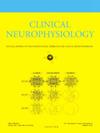Neuromagnetic evidence of the foot primary somatosensory area in the frontal cortex
IF 3.7
3区 医学
Q1 CLINICAL NEUROLOGY
引用次数: 0
Abstract
Objective
The location of the foot primary somatosensory area (SI) is puzzling in contrast to the parietal localization of the hand SI. Electrical cortical stimulation studies have revealed the foot somatosensory function in the paracentral lobule anterior and posterior to the central sulcus (CS). A recent study of intraoperative somatosensory evoked potentials (SEPs) using posterior tibial nerve (PTN) stimulation revealed frontal localization of the foot SI. However, most previous studies using scalp SEPs and somatosensory evoked magnetic fields (SEFs) for PTN found that the initial cortical components (P40/P40m) were localized in the parietal lobe. This study evaluated the location of the equivalent current dipole (ECD) for PTN-SEFs on individual magnetic resonance imaging (MRI) in normal adults.
Methods
PTN-SEFs were recorded in 16 hemispheres of 8 normal subjects. The P40m ECD was superimposed on individual anatomical MRIs.
Result
Mean ECD location of the P40m was 3.1 ± 4.2 mm (mean ± standard error) anterior and 6.9 ± 4.2 mm inferior to the inferior end of the CS.
Conclusions
Our findings suggest frontal localization of the human foot SI.
Significance
The functional anatomy of the human foot SI cannot be established by extrapolation of the hand SI.
足部额叶皮层初级体感区的神经磁证据
目的与手部初级体感区(SI)的顶叶定位相比,足部初级体感区(SI)的位置令人困惑。皮层电刺激研究揭示了足部体感功能在中央沟(CS)前后的中央旁小叶。最近一项使用胫骨后神经(PTN)刺激术中躯体感觉诱发电位(sep)的研究揭示了足部SI的额部定位。然而,以往大多数使用头皮sep和体感诱发磁场(SEFs)检测PTN的研究发现,初始皮层成分(P40/P40m)位于顶叶。本研究评估了正常成人PTN-SEFs在个体磁共振成像(MRI)上等效电流偶极子(ECD)的位置。方法对8例正常人的16个大脑半球进行sptn - sef记录。在个体解剖mri上叠加P40m ECD。结果P40m的ECD位置平均为CS下端前移3.1±4.2 mm(平均±标准误差)和下移6.9±4.2 mm。结论我们的研究结果提示人足部SI的额部定位。意义:人类足部SI的功能解剖不能通过手SI的外推来建立。
本文章由计算机程序翻译,如有差异,请以英文原文为准。
求助全文
约1分钟内获得全文
求助全文
来源期刊

Clinical Neurophysiology
医学-临床神经学
CiteScore
8.70
自引率
6.40%
发文量
932
审稿时长
59 days
期刊介绍:
As of January 1999, The journal Electroencephalography and Clinical Neurophysiology, and its two sections Electromyography and Motor Control and Evoked Potentials have amalgamated to become this journal - Clinical Neurophysiology.
Clinical Neurophysiology is the official journal of the International Federation of Clinical Neurophysiology, the Brazilian Society of Clinical Neurophysiology, the Czech Society of Clinical Neurophysiology, the Italian Clinical Neurophysiology Society and the International Society of Intraoperative Neurophysiology.The journal is dedicated to fostering research and disseminating information on all aspects of both normal and abnormal functioning of the nervous system. The key aim of the publication is to disseminate scholarly reports on the pathophysiology underlying diseases of the central and peripheral nervous system of human patients. Clinical trials that use neurophysiological measures to document change are encouraged, as are manuscripts reporting data on integrated neuroimaging of central nervous function including, but not limited to, functional MRI, MEG, EEG, PET and other neuroimaging modalities.
 求助内容:
求助内容: 应助结果提醒方式:
应助结果提醒方式:


